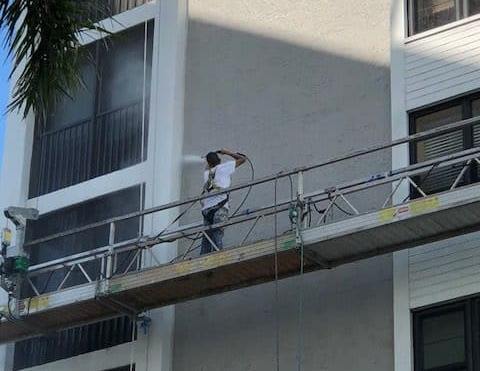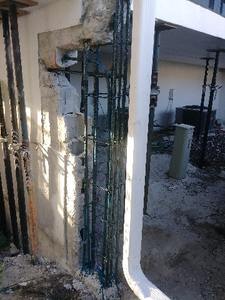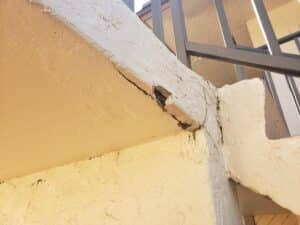Painting high rise buildings is a challenging and complex task that requires thorough preparation and strict adherence to safety protocols. Ensuring the safety of workers is paramount when dealing with such heights, and proper planning can make a significant difference. From understanding the job’s scope to organizing equipment and setting up secure work areas, careful preparation can help prevent accidents and ensure a smooth, efficient operation.
Additionally, using the right safety gear and equipment is crucial. High-rise painting involves working at great heights, where even a minor mistake can have severe consequences. Personal protective equipment (PPE) like harnesses, helmets, and gloves provide essential protection. Equip workers with high-quality gear and ensure they are trained on its proper use to maximize safety.
Moreover, safety techniques and protocols play a vital role in maintaining a secure working environment. Specific methods, such as using scaffolding correctly and implementing fall protection measures, help guard against common high-rise hazards. Familiarizing workers with these techniques ensures they can perform their tasks confidently and safely.
Finally, being prepared for emergencies is an integral part of any high-rise painting project. Establishing clear procedures and protocols for potential accidents and emergencies can save lives and reduce the impact of unexpected incidents. Having a well-drilled plan ensures that all workers know exactly what to do in case of an emergency, promoting a safe and efficient worksite.
Planning and Preparing for Safety
Proper planning and preparation are essential before starting any high-rise painting project. This begins with a thorough assessment of the building and the work environment. Identifying potential hazards that could affect the safety of workers is crucial. This includes evaluating the structure’s stability, the condition of the surfaces to be painted, and the surrounding areas that might impact the work.
After the initial assessment, develop a detailed plan that outlines the steps to be taken throughout the project. This plan should include schedules, the types of equipment to be used, and specific safety measures that will be in place. It’s important to communicate this plan clearly to all team members and ensure that everyone understands their roles and responsibilities.
Additionally, securing the necessary permits and ensuring compliance with local regulations is a vital part of the preparation. Each municipality may have different requirements for high-rise work, and adhering to these regulations helps avoid legal issues and enhances safety. Conducting regular briefings and daily inspections also ensures ongoing adherence to the safety plan and helps identify any emerging risks promptly.
Essential Safety Gear and Equipment
Using the right safety gear and equipment is vital for protecting workers engaged in high-rise painting. Here are some essential items every worker should have:
1. Harnesses and Fall Arrest Systems: These are crucial for preventing falls, which are one of the most significant hazards in high-rise work. Properly fitted harnesses and reliable fall arrest systems can save lives and reduce injury risk.
2. Helmets and Hard Hats: Protecting the head from falling debris and accidental bumps is essential. Helmets should comply with safety standards and be worn at all times on the job site.
3. Safety Glasses and Face Shields: Eye protection is necessary to shield workers from paint splatter, dust, and other particles. Safety glasses or face shields should be included in the standard protective gear.
4. Gloves and Protective Clothing: Gloves protect hands from harsh chemicals and rough surfaces, while protective clothing shields the body from spills, splashes, and abrasions. Both should be comfortable and suitable for the work environment.
5. Scaffolding and Ladders: Using secure scaffolding and sturdy ladders ensures stability and safety when working at heights. These should be properly inspected and maintained to prevent accidents.
6. Communication Devices: Since high-rise work often involves being spread out vertically, efficient communication devices like radios or walkie-talkies are essential for keeping everyone coordinated and informed.
By equipping workers with the appropriate safety gear and ensuring they know how to use it correctly, we can significantly reduce the risks associated with high-rise painting projects. Proper training on the use and maintenance of this equipment is also critical for ongoing safety.
Techniques for Ensuring Worker Safety
Safety techniques are fundamental to protecting workers during high-rise painting projects. Implementing and training the team on these techniques ensures everyone knows how to handle potential hazards effectively.
1. Proper Scaffolding Setup: Erecting scaffolding correctly is essential. Ensure it is stable, secured, and has guardrails. Regularly inspect the scaffolding for any signs of wear and tear, and never exceed its weight capacity.
2. Fall Protection Measures: Employing fall protection measures such as safety nets and harness anchors is critical. Workers must be attached to these anchors anytime they are working at height. Installing temporary edge protection also helps prevent accidental falls.
3. Weather Monitoring: High-rise work is heavily influenced by weather conditions. Strong winds, rain, and lightning can pose serious dangers. Always monitor weather forecasts and halt work during adverse conditions to ensure worker safety.
4. Work Area Organization: Keeping the work area tidy and free from unnecessary items reduces the risk of trips and falls. Organizing tools and materials at designated spots ensures a clutter-free environment, promoting safer movement around the site.
5. Training and Drills: Regular training sessions and safety drills help workers stay prepared for potential emergencies. Ensuring everyone understands and practices safety procedures promotes a culture of safety awareness.
By following these safety techniques and reinforcing them through continuous training, we can create a safer work environment for all involved in high-rise painting projects.
Emergency Procedures and Protocols
Being prepared for emergencies is a crucial aspect of high-rise painting safety. Having clear procedures and protocols ensures swift action can be taken to minimize harm and manage incidents effectively.
1. Emergency Contact Information: Display emergency contact numbers clearly at the work site. This includes medical services, local authorities, and site supervisors. Ensuring all workers have access to these contacts can expedite responses in emergencies.
2. First Aid Kits: Well-stocked first aid kits should be accessible on-site. These kits must include supplies for treating minor injuries, burns, and cuts. Regularly check the kits to ensure they are fully stocked and items are not expired.
3. Evacuation Plans: Develop and regularly practice an evacuation plan. All workers should know the quickest and safest routes to exit the building in case of an emergency. Conduct drills frequently to reinforce these procedures.
4. Incident Reporting Systems: Implement a system for reporting accidents and near-misses. Documenting these incidents helps understand their causes and prevent future occurrences. Encourage workers to report all safety concerns immediately.
5. Rescue Operations: Train workers on rescue procedures for situations where someone might be suspended from a harness or trapped. Having designated rescue personnel and the necessary equipment on-site is essential for quick response.
By establishing these emergency procedures and protocols, we ensure that our team is prepared to handle any situation efficiently, reducing risks and potential harm.
Conclusion
Safety is paramount in high-rise painting projects. From meticulous planning and preparation to using essential safety gear and equipment, every step is vital for protecting workers. Employing the right safety techniques and being prepared for emergencies further ensures that the job is completed without incidents.
At McLeod’s Contracting Solutions, we prioritize creating safe working environments for all our projects. Whether you need concrete and stucco restoration or waterproofs and sealants, our commitment to safety remains unwavering. Maintaining high safety standards not only protects our workers but also ensures the successful completion of your project.
Ready to embark on your next high rise building painting project with a team that values safety? Contact McLeod’s Contracting Solutions today to discuss your needs and see how we can help you achieve your goals safely and efficiently.







